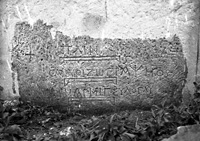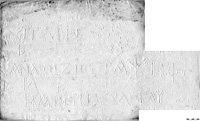 MAMA XI 254 (Laodikeia)
MAMA XI 254 (Laodikeia) 
Official measures of length for craftsmen
- Type of monument:
- Uncertain.
- Location:
- Ladık (Laodikeia): in the wall of the school.
- Description:
- Grey marble block, apparently complete. Erased cross at top left. Inscription in three lines, separated by long shallow incised rectangles (‘rulers’), with wedge-shaped nibs pointing downwards at each end. Uppermost ruler (below line 1), 0.365m long; middle ruler (below line 2), 0.324m long; lower ruler (below line 3), 0.285m long.
- Dimensions:
- Ht. 0.84; W. 1.22; Th. --; letters 0.025-0.045.
- Record:
- Squeeze; AH notebook copy; photograph (1957/89=5938).
- Publication:
- None.
- Date:
- AD 301-5(?).
πλιν,
σανς, λιθις, ζωγρας, ψηφς,
μαρς, μωσς, ξυλογλυ.





I know no parallels for a monument of this kind. The stone carries three different linear measures, evidently representing different lengths of foot, accompanied by abbreviated versions of the names of eight artisanal professions. Clearly we are dealing with a set of length-standards to be observed by different groups of craftsmen at Laodikeia. The professions involved may be identified as follows:
(1) πλιν. This evidently has something to do with bricks (πλίνθοι), either bricklaying (πλινθοβολία, πλινθοβόλος) or, less likely, brick-making (πλινθοποιία, πλινθουργία, πλινθουλκία etc.). In Diocletian’s Prices Edict, bricklayers are paid by the day, but the individual bricks are specified as being either one foot or two feet in length (PE 7.15, lateribus... pedum binum/πλίνθους... ἐκ πο(δῶν) β΄; Erim and Reynolds 1973: 103, Col. III 21-2: laterem bipedaneum/pedalem).
(2) σανς. This ought to derive from the Greek term for a wooden panel, σανίς or σανίδιον (cf. the verb σανιδοῦσθαι in SEG 40, 1127). The term seems to refer in particular to fine timber-work used for doors, panels, grilles, beds and tables, and so forth (Hellmann 1992: 366-8). In Diocletian’s Prices Edict, a specific rate is given for the sawing of timber by the foot (in pede per pede: PE 12.15-16, with Meiggs 1982: 516-7). At the end of the fifth century BC, the sawyer Rhaidios was paid by the foot for his work on the Erechtheion (IG I3 475, lines 56-63), and in the late 340s BC, the sawyer Teledamos was paid five copper coins per foot of work on the temple of Apollo at Delphi (τὸν πόδα [ἕκαστον χαλ]κῶν πέντε, CID II 46, III.7-14).
(3) λιθις. This ought to refer to stone-working or stone-masonry of some kind, although exactly what term is being abbreviated by λιθι- is unclear: the various specialist skills of stone-masonry all begin with λιθο- not λιθι- (λιθουργός, λιθοξόος, λιθοτόμος etc.; cf. the adjectives λιθικός, λίθινος). See further below, (6).
(4) ζωγρας. Evidently ζωγρα(φία), ζώγρα(φος), ‘wall-painting/a wall-painter’.
(5) ψηφς. This refers to a mosaicist, regularly known in Late Antiquity as a ψηφοθέτης or ψηφιωτής (Donderer 1989: 20-21). In the Prices Edict (PE 7.6-7), the ψηφοθέτης (tessellarius) is distinguished from the μουσιάριος (musaearius); the maximum pay for a musaearius is higher than for a tessellarius, and hence the distinction may be between wall and floor mosaics, or between fine decoration and simple tessellated patterns (Dunbabin 1999: 275-6).
(6) μαρς. We are presumably dealing with an abbreviation of the common Late Antique and Byzantine term μαρμαράριος (from the Latin marmorarius), one who works with or lays opus sectile or marble revetments: see Robert, Hellenica XI/XII, 28-30; Mitchell 1977: 101-2, no. 50 (a marble-worker at early Byzantine Ankyra). The Prices Edict gives the daily maximum pay for a marmorarius/μαρμαράριος (PE 7.5); maximum prices for fine marble of the kind used by marmorarii are listed by the (cubic or square) foot (PE 33.1-18; Ballance, in Erim and Reynolds 1970: 134-6; Corcoran and DeLaine 1994).
(7) μωσς. This refers to a mosaicist (μουσώτης, μουσιάριος: Donderer 1989: 18-19; SEG 51, 2062) engaged in finer or more artistic work than a ψηφοθέτης: see above under (5). For the variation μωσ-/μουσ-, cf. μωλίων/μουλίων, φώλων/φουλίων (Robert, Hellenica XI/XII, 29 n.2).
(8) ξυλογλυ. This can only refer to ξυλογλυ(φία), ξυλογλύ(φος), ‘sculpture/a sculptor in wood’; see the commentary to MAMA XI 336 (1956/178: Perta).
Fixed standards of length are very rare in the Graeco-Roman world (Coulton 1975: 85-7). A stone slab from the macellum at Lepcis Magna depicts two cubits of different length and a Roman foot, all of them subdivided into various parts (Ioppolo 1967); two anthropomorphic reliefs are known from the Greek world, one from Salamis on Cyprus, the other of unknown provenance, now in the Ashmolean museum in Oxford (Dekoulakou-Sideris 1990; Wilson Jones 2000). I know of no parallels for a set of different length-standards for different artisanal crafts. However, one particular historical context may perhaps be proposed for the Laodikeia monument. As we have seen, the publication of Diocletian’s Prices Edict in AD 301 (Corcoran 2000: 204-33) imposed a set of maximum prices on materials and labour for all of the artisans represented on the Laodikeia monument. The price of bricks, fine marble (used both by workers in opus sectile and mosaicists) and sawn timber was now regulated by the foot. The Laodikeia monument may thus have arisen from a particular difficulty in implementing the Prices Edict in a provincial context: which length of foot was a wholesale trader or individual artisan required to use in each instance?
I leave the ‘identification’ of the three lengths of foot (c. 0.365m, c. 0.324m, c. 0.285m) represented on the Laodikeia stone to metrological specialists. However, it is striking that the longest foot was used by the least skilled workers (brick-layers), while the shortest foot was used by the most skilled craftsmen (workers in opus sectile, fine mosaicists, sculptors in wood). This is arguably as we might expect, since the more delicate work would normally be paid at a higher rate per linear or square foot. The artisanal craftsmen listed here would all have been in regular employment in domestic and ecclesiastical contexts in fourth-century Laodikeia: in his homily In Divites, Basil refers to those wealthy men who spend their money on ‘marble-workers, carpenters, mosaicists and painters’ (λιθοξόοις, τέκτοσι, ψηφοθέταις, ζωγράφοις: Hom. In Div. 4, with Robert, Hellenica XI/XII, 33); in the second quarter of the fourth century, the bishop Eugenios paid for the construction of a new church at Laodikeia, ‘along with all the adornment (κόσμος) associated with it, that is to say, the colonnades, the quadrangle, the wall-paintings, the mosaics, the fountain, the propylon, and all the marble decoration’ (στοῶν τε καὶ τ[ετ]ραστόων καὶ ζωγραφιῶ̣[ν] καὶ κεντήσεων κὲ ὑδρείου καὶ προπύλου καὶ πᾶσι τοῖς λιθοξοϊκοῖς ἔργοις: MAMA I 170; Tabbernee 1997: 426-36, no. 69).